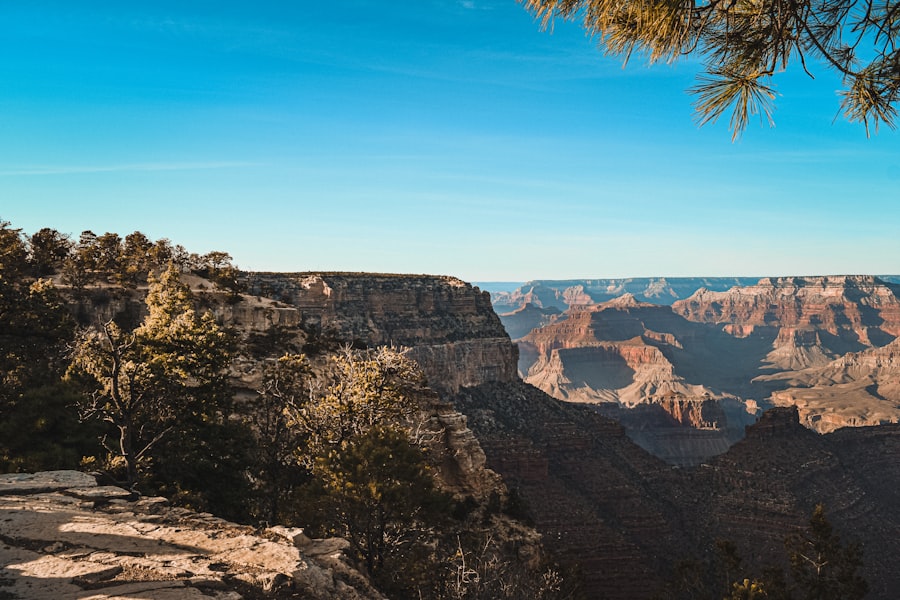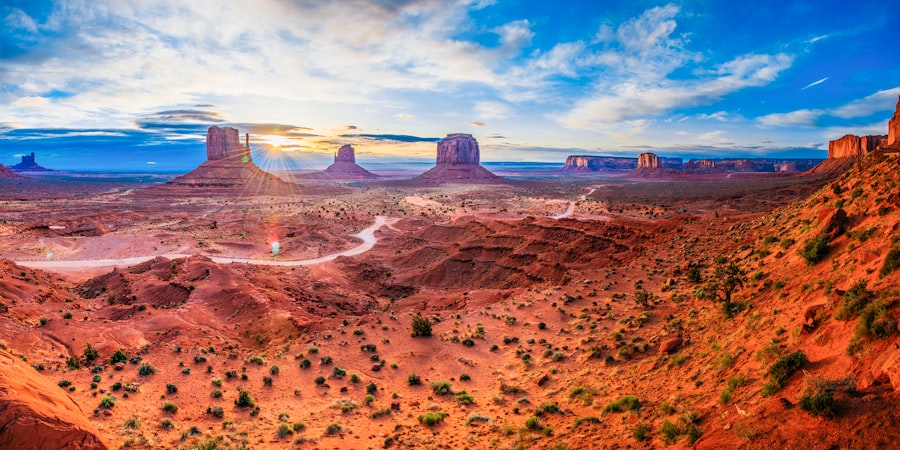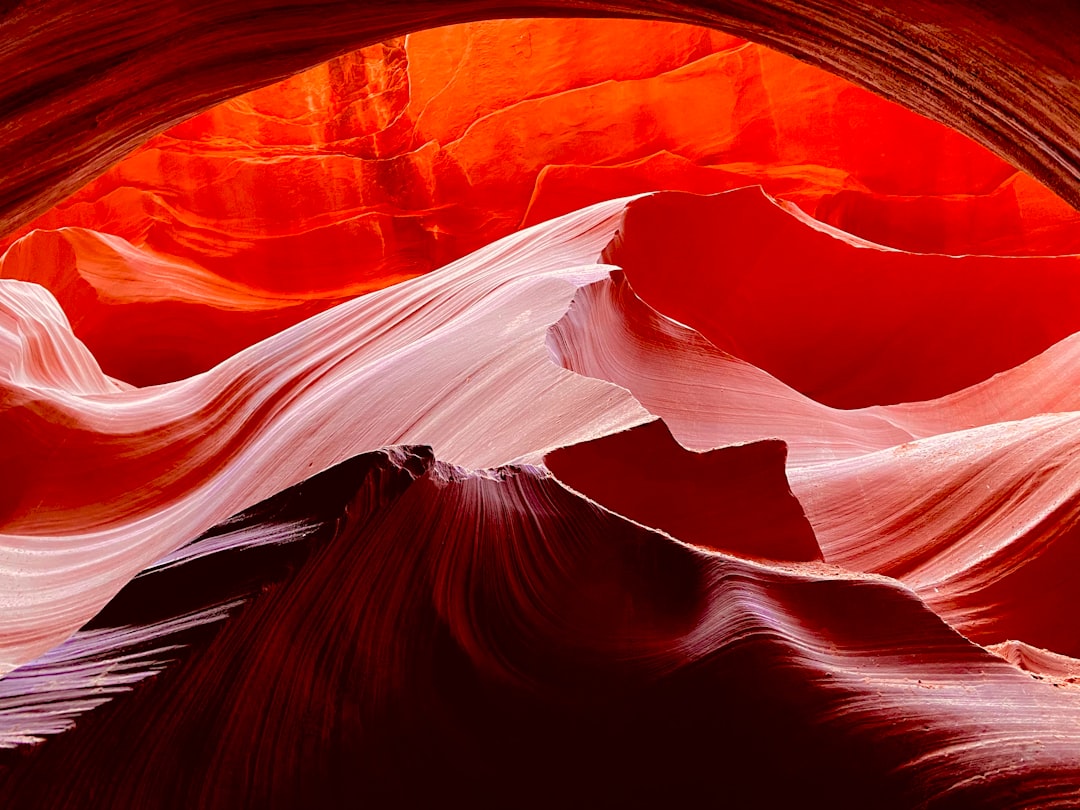The Grand Canyon stands as one of the most awe-inspiring geological formations on the planet, a testament to the Earth’s dynamic history. Carved by the relentless flow of the Colorado River over millions of years, this immense chasm stretches approximately 277 miles in length, reaching depths of over a mile in some areas. The canyon’s walls reveal a stunning array of rock layers, each telling a story of the Earth’s past, from ancient seas to volcanic activity.
The vibrant colors of the rock strata, ranging from deep reds to soft yellows, create a breathtaking palette that changes with the shifting light throughout the day. Geologists and visitors alike marvel at the intricate processes that shaped this natural wonder. The interplay of erosion, sedimentation, and tectonic activity has resulted in a landscape that is not only visually striking but also rich in scientific significance.
The Grand Canyon serves as a natural laboratory for studying geological processes, offering insights into the Earth’s history and the forces that continue to shape it. As one gazes into its depths, it becomes clear that the Grand Canyon is not merely a scenic vista; it is a living chronicle of time itself.
Key Takeaways
- The Grand Canyon is a geological marvel, showcasing millions of years of Earth’s history through its layers of rock and stunning formations.
- The canyon has a rich history, with evidence of human presence dating back thousands of years, including the ancient Pueblo people and early European explorers.
- The diverse ecosystem of the Grand Canyon supports a wide variety of plant and animal species, adapted to its unique and challenging environment.
- Exploring the indigenous culture of the Grand Canyon offers a glimpse into the traditions and beliefs of the Native American tribes who have called the area home for centuries.
- The Grand Canyon offers thrilling adventure activities such as hiking, rafting, and helicopter tours, providing visitors with unforgettable experiences in the great outdoors.
The Rich History of the Grand Canyon
The history of the Grand Canyon is as layered and complex as its geological formations. Long before it became a national park, the canyon was home to various Indigenous peoples who thrived in its diverse environments. Tribes such as the Havasupai, Hualapai, Navajo, and Hopi have inhabited the region for thousands of years, developing rich cultures and traditions deeply intertwined with the land.
Their stories, passed down through generations, reflect a profound connection to the canyon, viewing it not just as a physical space but as a sacred entity imbued with spiritual significance. In more recent history, European explorers began to document the Grand Canyon in the 19th century, bringing attention to its grandeur and beauty. John Wesley Powell’s expedition in 1869 marked a pivotal moment in American exploration, as he navigated the Colorado River through the canyon, providing valuable maps and insights into this uncharted territory.
The establishment of Grand Canyon National Park in 1919 further solidified its status as a national treasure, ensuring its preservation for future generations while also opening it up to visitors from around the world.
The Diverse Ecosystem of the Grand Canyon

The Grand Canyon is not only a geological wonder but also a vibrant ecosystem teeming with life. Spanning multiple climate zones—from arid desert at lower elevations to lush forests at higher altitudes—the canyon supports an astonishing variety of flora and fauna. This diversity is largely attributed to its unique topography and microclimates, which create distinct habitats for countless species.
From the iconic desert bighorn sheep that roam the rocky cliffs to the myriad bird species that soar above, the canyon is a sanctuary for wildlife. Plant life in the Grand Canyon is equally diverse, with over 1,500 species documented within its boundaries. Cacti and wildflowers flourish in the sun-drenched lower elevations, while ponderosa pines and aspen trees thrive in the cooler, higher regions.
This rich tapestry of vegetation not only provides food and shelter for wildlife but also plays a crucial role in maintaining the ecological balance of the area. The interconnectedness of these ecosystems highlights the importance of preserving such natural habitats for future generations.
Exploring the Indigenous Culture of the Grand Canyon
| Aspect | Metrics |
|---|---|
| Number of Indigenous Tribes | 11 |
| Visitors Engaging with Indigenous Culture | Approximately 50,000 annually |
| Indigenous Cultural Sites | Over 4,000 |
| Indigenous Languages | More than 20 spoken |
The Indigenous cultures surrounding the Grand Canyon are deeply rooted in its landscape, with traditions and practices that have evolved over millennia. For these communities, the canyon is more than just a geographical feature; it is a source of identity and spirituality. Many tribes hold sacred ceremonies that honor their ancestors and celebrate their connection to the land.
These rituals often involve storytelling, music, and dance, reflecting their deep respect for nature and its cycles. Visitors to the Grand Canyon have the opportunity to engage with these rich cultural traditions through various programs and events organized by Indigenous communities. Guided tours led by tribal members offer insights into their history, art, and spiritual beliefs.
Such experiences foster a greater understanding of how these cultures have adapted to their environment while maintaining their heritage. By learning from Indigenous perspectives, visitors can gain a deeper appreciation for the Grand Canyon’s significance beyond its physical beauty.
The Thrilling Adventure Activities at the Grand Canyon
For those seeking adventure, the Grand Canyon offers an array of exhilarating activities that cater to thrill-seekers and nature enthusiasts alike. Rafting down the Colorado River is one of the most popular ways to experience the canyon’s grandeur up close. Navigating through its rapids provides an adrenaline rush while allowing participants to witness breathtaking views from a unique vantage point.
Guided rafting trips range from leisurely floats to challenging white-water excursions, ensuring there is something for everyone. Hiking is another exhilarating way to explore this vast landscape. Trails such as the Bright Angel Trail and South Kaibab Trail lead adventurers down into the canyon’s depths, offering stunning vistas along the way.
For those looking for an even more immersive experience, backpacking trips allow hikers to spend multiple days traversing remote areas of the canyon, camping under starry skies and soaking in the tranquility of nature. Whether it’s scaling cliffs or navigating winding trails, adventure awaits at every turn in this remarkable destination.
The Spectacular Views of the Grand Canyon

The views from various vantage points within the Grand Canyon are nothing short of spectacular, captivating visitors with their sheer beauty and scale. Iconic overlooks such as Mather Point and Yavapai Observation Station provide panoramic vistas that stretch for miles, showcasing layers of rock formations bathed in sunlight.
Sunrise and sunset are particularly magical times to witness these breathtaking views. As dawn breaks or dusk falls, the changing light casts an ethereal glow over the canyon walls, transforming them into a canvas of vibrant colors. Photographers flock to these moments, eager to capture the fleeting beauty that unfolds before their eyes.
The ever-changing landscape serves as a reminder of nature’s artistry and invites contemplation on one’s place within this grand tapestry.
The Hidden Gems of the Grand Canyon
While many visitors flock to popular viewpoints and trails, there are hidden gems within the Grand Canyon waiting to be discovered by those willing to venture off the beaten path. Places like Havasu Falls offer stunning turquoise waters cascading over red rock formations—a sight that feels almost otherworldly. Accessible only by hiking or helicopter, this secluded oasis provides a serene escape from the more crowded areas of the park.
Another lesser-known treasure is the North Rim, which receives fewer visitors than its southern counterpart yet boasts equally breathtaking views and unique flora. The North Rim’s cooler climate supports lush forests and diverse wildlife, making it an ideal spot for those seeking solitude amidst nature’s splendor. Exploring these hidden gems allows visitors to experience a different side of the Grand Canyon—one that is tranquil and untouched by large crowds.
The Mysterious Caves and Caverns of the Grand Canyon
Beneath its surface lies a network of mysterious caves and caverns that add another layer of intrigue to the Grand Canyon’s allure.
Some caves are accessible to adventurous explorers, offering guided tours that reveal stunning stalactites and stalagmites while providing insights into their formation.
One notable cave system is Lava Falls Cave, located near one of the canyon’s most challenging rapids. This cave showcases unique geological features formed by volcanic activity millions of years ago. Exploring such caves not only offers an exciting adventure but also allows visitors to connect with another aspect of the canyon’s geological history—one that remains hidden from view above ground.
The Fascinating Flora and Fauna of the Grand Canyon
The flora and fauna found within the Grand Canyon are as diverse as they are fascinating. With over 1,500 plant species recorded in this unique environment, visitors can encounter everything from hardy desert plants like sagebrush and yucca to towering coniferous trees at higher elevations. This rich botanical diversity supports an equally varied array of wildlife, including mammals such as mule deer and mountain lions, as well as numerous bird species like peregrine falcons and California condors.
The seasonal changes within this ecosystem bring about remarkable transformations in both plant life and animal behavior. Springtime sees wildflowers bloom across meadows while migratory birds return to nest in lush foliage. In contrast, summer brings warmth that attracts reptiles basking on sunlit rocks.
Observing these natural cycles offers visitors an opportunity to appreciate not only the beauty but also the resilience of life thriving in such an extreme environment.
The Importance of Conservation Efforts at the Grand Canyon
As one of America’s most cherished natural wonders, conservation efforts at the Grand Canyon are vital for preserving its ecological integrity and cultural heritage. Various organizations work tirelessly to protect this unique landscape from threats such as climate change, invasive species, and human impact. Initiatives aimed at restoring native habitats and promoting sustainable tourism practices play a crucial role in safeguarding both flora and fauna while ensuring future generations can enjoy this remarkable destination.
Education also plays a key role in conservation efforts at the Grand Canyon. By raising awareness about environmental issues and encouraging responsible behavior among visitors—such as adhering to Leave No Trace principles—park rangers aim to foster a sense of stewardship for this precious resource. Through collaborative efforts between Indigenous communities, government agencies, and conservation organizations, there is hope for maintaining not only the beauty but also the ecological health of this iconic landscape.
The Spiritual and Healing Powers of the Grand Canyon
Beyond its physical beauty lies a profound sense of spirituality associated with the Grand Canyon—a place where many find solace and healing amidst nature’s grandeur. For Indigenous peoples, this landscape holds deep spiritual significance; it is seen as a living entity that nurtures both body and soul. Many visitors report feeling a sense of peace or connection when standing on its rim or hiking through its depths—a testament to nature’s ability to inspire reflection and introspection.
The healing powers attributed to natural spaces like the Grand Canyon have garnered attention in recent years as more people seek refuge from modern life’s stresses. Whether through meditation practices overlooking vast vistas or simply immersing oneself in nature’s tranquility during hikes along winding trails—these experiences can foster emotional well-being and rejuvenation. In recognizing these spiritual dimensions within such landscapes, individuals may find not only beauty but also healing within themselves amidst this magnificent natural wonder.
In exploring the enigmatic allure of the Grand Canyon, one cannot overlook the fascinating insights provided by various articles that delve into its mysteries. A particularly intriguing piece can be found on X File Findings, which offers a comprehensive look at the hidden aspects of this natural wonder. For those interested in uncovering more about the secrets of the Grand Canyon, I recommend reading the related article available at X File Findings. This article provides a deeper understanding of the geological and historical elements that contribute to the canyon’s enduring mystique.
WATCH THIS! 👺 The Grand Canyon Cover-Up: Did the Smithsonian Hide Evidence of Giants?
FAQs
What are the secrets of the Grand Canyon?
The Grand Canyon holds many secrets, including hidden caves, ancient fossils, and mysterious rock formations that have puzzled scientists for years.
Are there any undiscovered areas in the Grand Canyon?
There are still unexplored and unmapped areas within the Grand Canyon, particularly in its remote and rugged regions.
What are some of the mysterious rock formations in the Grand Canyon?
The Grand Canyon is home to various enigmatic rock formations, such as the Vishnu Schist, which dates back over 1.7 billion years, and the mysterious “Black Dragon” formation.
Are there any hidden caves in the Grand Canyon?
Yes, there are numerous hidden caves within the Grand Canyon, some of which have yet to be fully explored and documented.
What ancient fossils have been discovered in the Grand Canyon?
The Grand Canyon has yielded numerous ancient fossils, including those of prehistoric marine creatures, early reptiles, and even some dinosaur remains.
